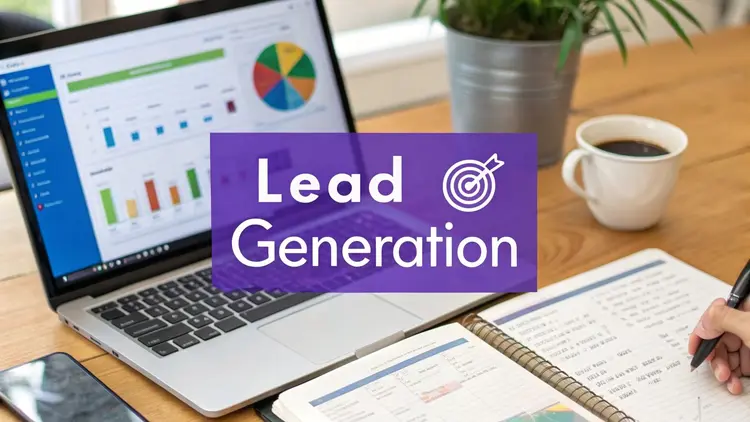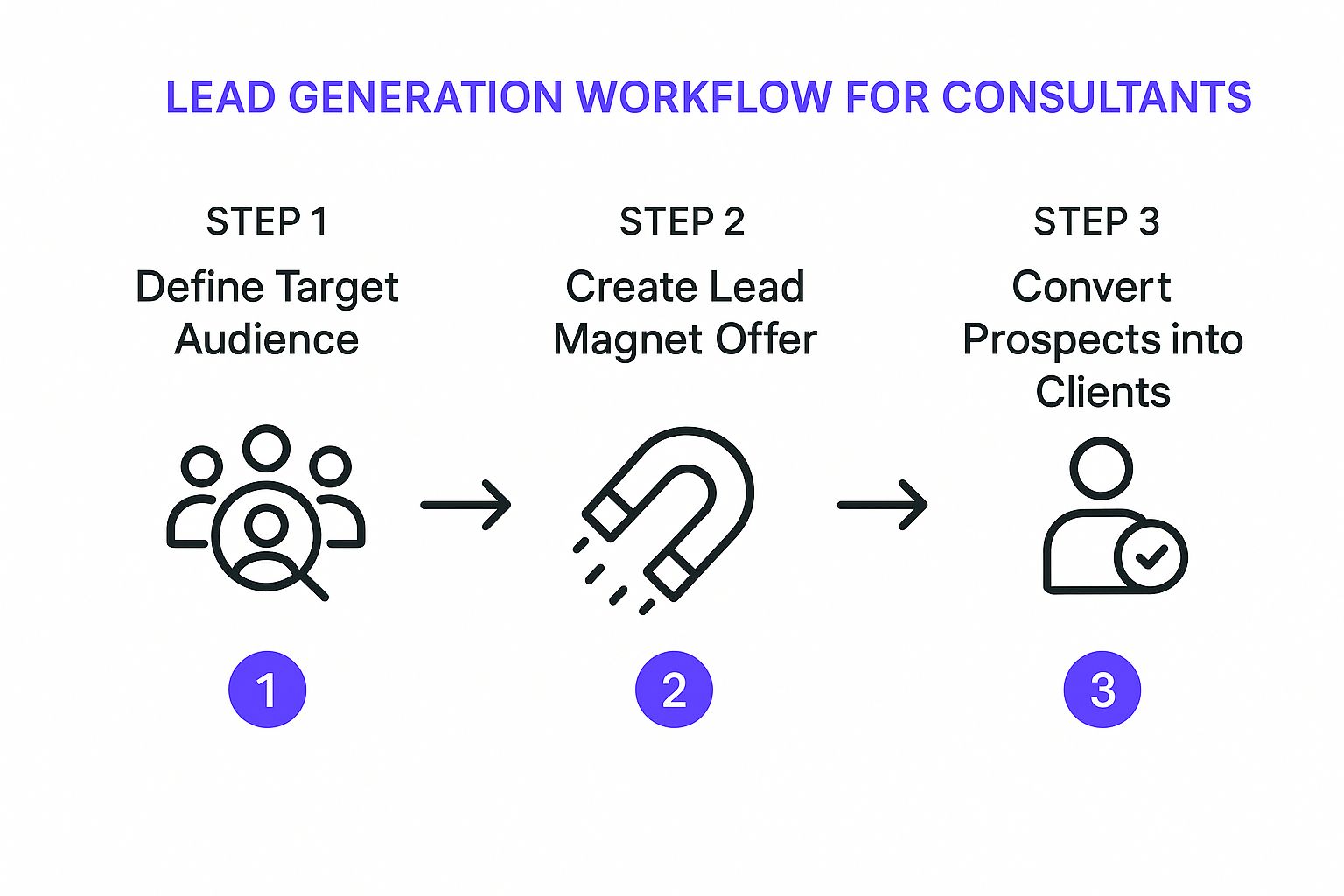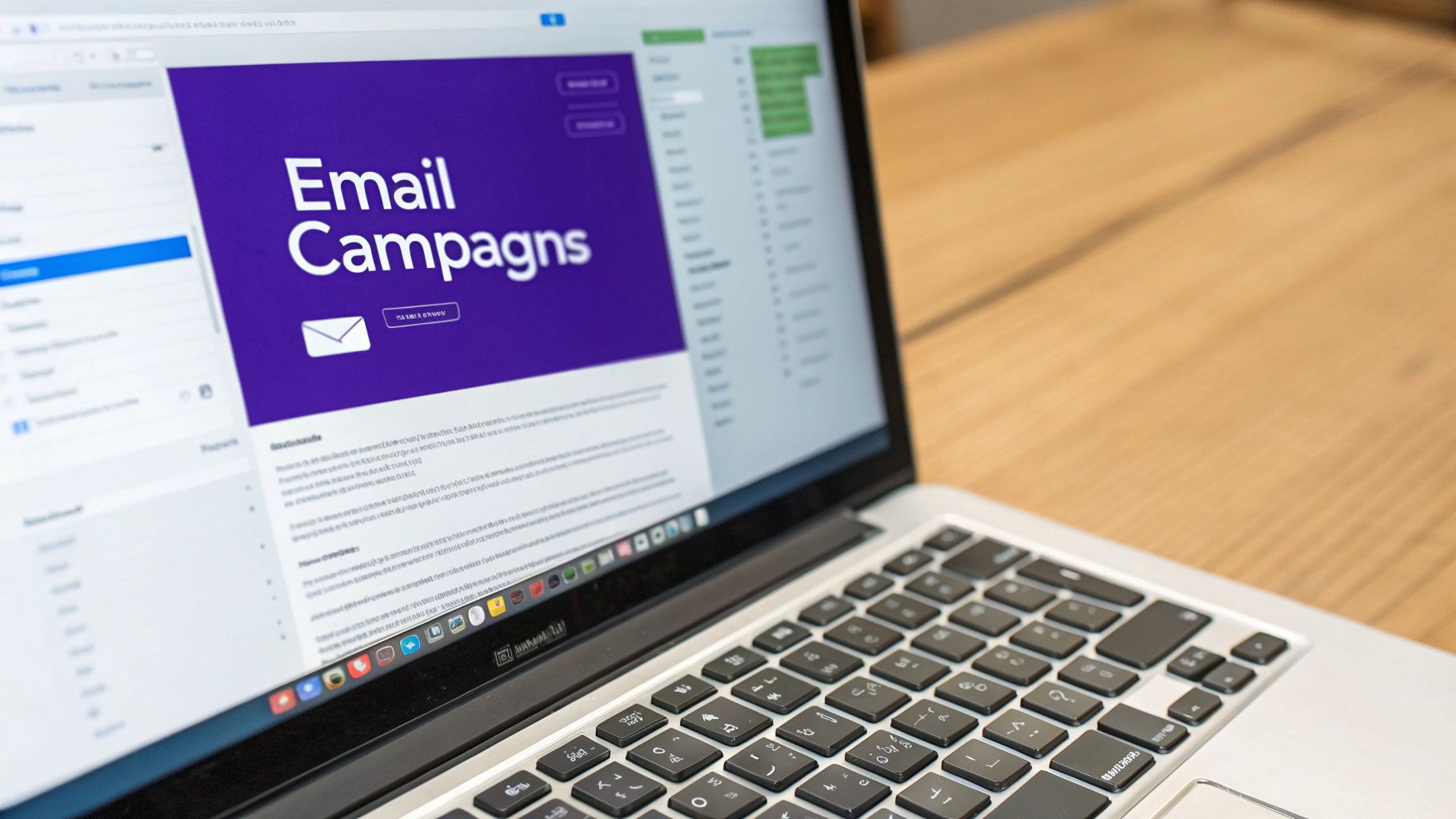Lead Generation for Consultants Guide

Let's be honest: the feast-or-famine cycle is exhausting. Effective lead generation for consultants is all about building a system that consistently brings in high-quality prospects. It’s the key to finally ending that constant, stressful scramble for the next project.
When you get this right, you start attracting clients who already see your value and are prepared to invest in your expertise.
Build a Predictable Consulting Pipeline
For too many independent consultants, relying on a single source of new business—like referrals from a couple of past clients—is a recipe for anxiety. One month you’re buried in work, and the next you’re staring at a blank calendar, wondering where the next project is coming from. That kind of inconsistency makes it impossible to plan, invest back into your business, or grow with any real confidence.
The answer is to build a predictable, multi-channel system. The most successful consultants I know don't just wait for leads to fall into their laps. They've built an engine designed to attract, engage, and convert their ideal clients. It's less about chasing every shiny object and more about strategically positioning yourself as the go-to expert in your niche.
The Core Pillars of Your Lead Engine
A truly robust pipeline is built on four foundational pillars. Think of them like the legs of a table—if one is weak, the whole thing gets wobbly. When all four work together, you create incredible momentum and stability.
To get a clearer picture of how these pillars function, let's break them down. Each one has a distinct goal and requires specific activities to make it work.
Your Core Lead Generation Pillars
Pillar | Primary Goal | Key Activities |
|---|---|---|
Digital Presence | Capture inbound interest and guide visitors to take action. | Optimizing your website and social media profiles, creating clear calls-to-action. |
Establishing Authority | Build trust and prove your expertise before the first call. | Writing articles, creating case studies, speaking at industry events, hosting webinars. |
Strategic Networking | Generate high-quality, pre-qualified leads through relationships. | Building a referral network with partners, systematically asking past clients for introductions. |
Nurturing Relationships | Stay top-of-mind with prospects who aren't ready to buy yet. | Sending a valuable email newsletter, sharing helpful content, personalized check-ins. |
By focusing on these four areas, you build a comprehensive system that doesn't depend on any single source. This is how you create a predictable flow of opportunities.
The simple workflow below shows exactly how you can turn initial interest into paying clients. It’s a disciplined process that’s becoming the standard for good reason.

This isn’t random. Successful lead generation is a structured journey, guiding a prospect from the moment they discover you to the day they sign a contract.
And this disciplined approach is what’s separating the thriving consultants from the struggling ones. The market data backs this up.
The lead generation industry is getting serious attention, with 50% of marketers now calling it a top priority. This focus is driving real money into the space, with the market expected to hit $3.7 billion by 2027. You can learn more about these lead generation trends and what they mean for consultants.
This shift confirms that putting real effort into a structured lead generation process isn't just a nice-to-have anymore. It’s a core business function for anyone who wants to grow. By focusing on these pillars, you can finally move away from a reactive, unpredictable business and build one that delivers a reliable stream of fantastic opportunities.
Turn Your Digital Presence Into a Lead Magnet
Think of your website and LinkedIn profile as your digital storefronts. They're working for you 24/7, making a first impression on potential clients long before you ever shake a hand or jump on a call. But just having them online isn't enough. For lead generation for consultants to really work, you have to turn these digital assets into powerful magnets that actively pull in your ideal prospects.
This is about shifting from a passive, "here's my brochure" mindset to an active one. Your digital presence needs to be engineered to attract the right people and gently nudge them toward taking a specific action. It’s the difference between a pretty business card and a salesperson who consistently brings in qualified leads.
Optimize Your Website for Conversion
Most prospects will vet you online before they ever agree to a meeting. Your website is often their first stop, so it needs to do more than just list what you do—it has to resonate with their biggest challenges and clearly show you're the one with the solution. Every single page needs a job to do.
Your service pages are where the rubber meets the road. Stop just describing your services. Instead, frame them around the tangible results you deliver. A marketing consultant doesn't simply "offer SEO services." They "help B2B tech companies double their qualified demo requests in six months." See the difference? One is a feature; the other is a future they can't wait to have.
Here are three things you can do right now to make your site work harder:
Nail Your Headline: Your homepage headline needs to immediately answer two questions for your ideal client: "Who do you help?" and "What problem do you solve?" Be specific and focus on the benefit.
Use Strategic Calls-to-Action (CTAs): Don't leave visitors wondering what to do next. Every page should guide them with clear, compelling buttons like "Book a Discovery Call," "Download My Free Guide," or "Get a Custom Proposal."
Showcase Social Proof: Nothing builds trust faster than seeing that others have already succeeded with you. Weave in testimonials, client logos, and short, punchy case studies throughout your site. This instantly lowers a prospect's guard.
One of the most common mistakes I see is burying the call to action. A potential client should never have to search for how to get in touch. Make it obvious, make it easy, and make it compelling on every single page.
This approach transforms your website from a static online resume into a dynamic, lead-generating machine.
Transform LinkedIn From a Resume to a Lead Source
For any B2B consultant, LinkedIn is non-negotiable territory. Yet, most consultants treat it like a dusty CV, completely missing its incredible power as a lead source. Your mission here is to stop blending in and start standing out as an authority who genuinely engages with prospects, not just pitches them.
Your LinkedIn headline is your most valuable piece of digital real estate. Don't waste it on a generic job title. State your value proposition loud and clear. Instead of "Management Consultant," try something like, "I Help Manufacturing Firms Slash Operational Waste by 15% | Lean Six Sigma Expert." This immediately speaks to the right audience and repels the wrong one.
LinkedIn is built around content and expertise, creating hubs where experts share insights and prospects actively search for solutions.

This just goes to show that LinkedIn is a content-driven world. By actively participating and sharing what you know, you dramatically increase your visibility with the very people you want to work with.
But having a great profile is only half the battle. Consistent engagement is key.
Share Real Value: Post short articles, give your take on industry news, or break down a client success story. The goal is to educate and inform, not just broadcast.
Engage with Your Ideal Clients: Pinpoint decision-makers at companies you want to work with. But don't just send a cold connection request. Warm them up first. Leave thoughtful comments on their posts or share their content with your network. This builds familiarity and trust long before you ever ask for a meeting.
By treating your website and LinkedIn profile as active, integrated parts of your client acquisition strategy, you build a system that consistently brings the right people to your door. This sets the stage for more meaningful conversations and a pipeline you can actually count on.
Become the Go-To Expert in Your Niche

Let's be blunt: prospective clients aren't looking for a jack-of-all-trades. They are desperately searching for the one person who truly understands their specific, expensive, and often painful problem.
This means that real lead generation for consultants isn't about casting the widest net possible. It's about becoming the only logical choice for a very specific audience. Building this expert status is an active process, one that transforms you from a consultant chasing leads into a magnet for high-value clients who are already convinced of your expertise.
This kind of authority is built by strategically creating and sharing genuinely useful content. We're not talking about generic, 500-word blog posts. We’re talking about creating assets that put your deep knowledge on display and speak directly to the frustrations of your ideal client. Think insightful articles, in-depth white papers, or compelling case studies that solve a piece of their problem before they ever pay you a cent.
Crafting Content That Attracts Your Ideal Client
To create content that resonates, you first have to get inside your ideal client's head. What keeps them up at night? What are the biggest roadblocks to hitting their goals? What questions are they frantically typing into Google? Your content has to answer those questions with clarity and confidence.
Don't guess. Do the work.
Talk to your best clients. Ask them what life was like before they hired you. What were their biggest frustrations? Their exact words are your best source of content ideas.
Lurk in industry forums and social media groups. Pay attention to the recurring questions and common complaints. These are absolute goldmines for content.
Check out what your competitors are doing. See what topics they cover, but more importantly, look for the gaps. Where can you provide a sharper, more in-depth perspective?
Once you have a list of topics that you know your audience cares about, start building. A financial consultant who specializes in dental practices might create a detailed guide on "Navigating a Practice Acquisition." A logistics consultant could publish a case study showing precisely how they saved a client $500,000 in shipping costs. These pieces don't just tell people you're an expert; they show them.
The most effective content is often a direct answer to a question you've been asked by a client or prospect. If one person has that question, it’s a safe bet that hundreds of others do too. Turn that answer into a blog post, a video, or a checklist.
This approach ensures your marketing efforts are directly connected to the problems your market is willing to pay to solve.
Mastering Public Speaking for Lead Generation
While your written content builds a solid foundation of authority, nothing builds trust and generates qualified leads faster than public speaking. Standing on a "stage"—whether it's for an online webinar or at an in-person industry conference—instantly positions you as an expert. It's a powerful shortcut to credibility.
The secret is to treat every speaking opportunity as a strategic lead-generation activity, not just a performance. Your goal isn't only to educate; it's to inspire a handful of people in that audience to take the next step with you.
Here’s how to turn your speaking gigs into a reliable source of new business:
Find the Right Stages: Don't just speak anywhere. Target industry associations, podcasts, and online summits where your ideal clients are already gathered. If you're just starting, look at local chapters or niche podcasts to build your portfolio and refine your message.
Design a "Feeder" Presentation: Your talk should be incredibly valuable on its own but should naturally point toward a bigger conversation. Frame a common industry problem, present your unique framework for solving it, and show a clear path forward.
Make a Frictionless Offer: This is where most consultants drop the ball. They end a fantastic presentation with a weak, "Any questions?" or "Visit my website." Instead, you need a clear, compelling call to action. Offer a valuable resource—like the presentation slides, a unique checklist, or a deeper-dive guide—in exchange for their contact info.
For example, a marketing consultant could wrap up their talk by saying, “I’ve put together a 10-point audit checklist that covers everything we just discussed. You can get it on your phone right now by scanning this QR code on the screen.” This simple, direct offer turns passive listeners into active leads. Tools like SpeakerStacks are built for exactly this moment, letting you capture interest instantly from the stage.
By combining authoritative content with strategic speaking, you create a powerful one-two punch. Your content works 24/7 to build your reputation, while your speaking gigs create high-impact events that fill your pipeline with warm, qualified prospects ready to talk business.
Unlock High-Quality Leads Through Your Network
While digital marketing gets a lot of attention, some of the absolute best consulting leads will come from a source that's decidedly more human: your professional network. Referrals are pure gold. They arrive pre-sold on your value because a trusted colleague or a happy client has already vouched for you, instantly bypassing the skepticism that usually meets any kind of cold outreach.
The problem? Most consultants treat referrals like a happy accident instead of a core business strategy. They just wait for the phone to ring, hoping a past client remembers them at just the right moment. But if you want a reliable pipeline, you have to be proactive. It's about engineering these opportunities without feeling pushy or transactional.
This all starts with a mental shift. Your network isn't just a list of contacts; it's a living asset that needs to be managed, nurtured, and grown. It’s not just about who you know, but about building genuine, reciprocal relationships that make people want to send business your way.
Build Your Strategic Partner Network
Interestingly, your most powerful referral sources often aren't your direct clients. They're other professionals who serve the exact same audience but don't compete with you. Think of them as your strategic partners.
For example, a management consultant who helps startups scale could team up with a fractional CFO, an intellectual property lawyer, or a seed-stage venture capitalist. They all serve the same customer—an ambitious founder—but they solve different pieces of the puzzle.
Building these relationships is a long game built on mutual value. It’s not about sending a single LinkedIn message asking for leads. It’s about genuinely helping them first.
Here’s how to get started:
Map out your ecosystem: Make a list of professionals who work with your ideal client before they need you, during their engagement with you, or after your project is done.
Initiate a "give first" conversation: Reach out with a simple goal: learn about their business and see how you can help them. Ask about their ideal client and what kind of introductions would be most valuable.
Create referral opportunities: Once you understand what they need, keep your eyes and ears open. When you meet someone who fits their ideal client profile, make the introduction. You’re making deposits in the relationship bank.
This approach creates a web of advocates who truly understand your business and are actively looking for opportunities to send your way—because you do the same for them.
Systematically Tap Into Past and Current Clients
Your happiest clients are your best salespeople, but they're also busy. They aren't constantly thinking about who they can refer you to. You have to make it incredibly easy for them. The trick is to ask for an introduction at the moment of peak value, usually right after a project wraps up or when you’ve hit a major, successful milestone.
But don't just ask, "Do you know anyone who could use my help?" That's too vague and puts all the mental work on them. You have to be specific.
Try an approach like this: "I’m so glad we were able to achieve [specific, positive result]. I'm looking to connect with a few other leaders in the [client's industry] space who are also struggling with [the exact problem you solved]. Does anyone come to mind who might find a similar conversation valuable?"
This is a professional, targeted request that makes it easy for them to think of specific people. You're not asking for a favor; you're offering to extend the same value you already created for them to someone else in their circle.
This kind of disciplined follow-up is a powerful form of lead nurturing. Consistently engaging with past clients and partners keeps you top-of-mind and strengthens your relationships over time. The data backs this up, showing a clear link between this kind of attention and real business results. Companies that excel at lead nurturing generate 50% more sales-qualified leads at a 33% lower cost. You can discover more insights about lead nurturing at Sopro.io.
By building these small, consistent habits into your workflow, you create a powerful, self-sustaining referral engine that delivers a steady stream of your best-fit clients.
Use Email to Nurture Prospects Into Clients

Let's be clear: email marketing isn't about blasting out a monthly newsletter and hoping for the best. For a consultant, it’s the most powerful tool in your arsenal for building relationships at scale. It’s how you guide interested prospects from "just browsing" to "I need to hire you" without ever feeling pushy.
This whole process kicks off with a simple value exchange. You can't just stick a "sign up" box on your site and expect people to flock to it. You have to earn that email address. This is where a lead magnet comes into play—a high-value resource you offer for free in exchange for their contact info.
Think of it as the handshake that starts the conversation. It's a foundational piece of lead generation for consultants and the gateway to your entire pipeline.
Create Lead Magnets That People Actually Want
A truly effective lead magnet zeroes in on a specific, nagging problem for your ideal client. Generic pleas like "subscribe to my newsletter" just don't cut it anymore. People guard their inboxes fiercely, so your offer needs to be so compelling they can’t say no.
Some of the best lead magnets I've seen consultants use include:
Actionable Checklists: Something like a "15-Point Pre-Launch Audit for SaaS Products."
In-Depth Guides: A real-world playbook, such as "The Consultant's Guide to Pricing High-Value Projects."
Webinar Replays: The full recording of your most popular, high-impact presentation.
Resource Toolkits: A curated list of the exact tools and templates you personally use to deliver results.
The secret is to provide an immediate win. For instance, a project management consultant could offer a pre-built Trello board template that helps teams organize their next sprint instantly. It's practical, valuable, and directly showcases your expertise in action.
The best lead magnets feel like something you should have paid for. When a prospect gets that much value for free, it builds instant trust and positions you as a generous, confident expert.
That first impression sets the tone for everything that comes next.
Build an Automated Nurture Sequence
Once someone grabs your lead magnet, the real work begins. Don't just let that new contact sit on your list and go cold. This is your chance to build a relationship with an automated email series, often called a nurture sequence or welcome series.
This is not a sales pitch. It’s an educational onboarding process. The goal is to build trust, showcase your authority, and gently guide them toward booking a call when the time is right for them. This hands-off approach is incredibly effective.
There's a reason so many marketers lean on it. Data heading into 2025 shows that 48% of marketers see email as their most effective lead generation channel. And on the other side of the screen, 44% of shoppers say emails influence their buying decisions. You can dig into the full research on lead generation trends to see just how vital email has become.
A simple but killer nurture sequence could look like this:
Email 1 (Immediate): Delivers the lead magnet and offers a warm, personal welcome.
Email 2 (2 Days Later): Shares a powerful case study, showing a tangible result you got for a client just like them.
Email 3 (4 Days Later): Tackles a common industry myth or mistake, establishing you as a clear-thinking authority.
Email 4 (7 Days Later): Provides another piece of value—maybe a link to an insightful blog post or a short video tip.
Email 5 (10 Days Later): The soft invitation. Offer a no-pressure, 15-minute discovery call to talk about their specific challenges.
Segment Your List for Maximum Impact
As your list grows, you'll quickly realize that not everyone is interested in the same thing. Sending a one-size-fits-all message is a surefire way to get ignored or, worse, get a flood of unsubscribes. This is where segmentation is a game-changer.
You can slice your audience into different groups based on things like:
Which lead magnet they downloaded
Their industry
Whether they attended one of your webinars
For example, a consultant serving both marketing agencies and e-commerce brands should send entirely different case studies and content to each segment. That simple act of personalization makes your emails feel incredibly relevant. It reinforces that you don't just know your stuff—you know their world and their problems. When they're finally ready to hire, you become the obvious choice.
Answering the Tough Questions About Lead Generation
It's one thing to have a strategy on paper, but it's another thing entirely to live it day in and day out. When it comes to lead generation, a lot of questions pop up, and even the most seasoned consultants hit roadblocks.
Let's get practical and tackle the common hurdles I see consultants struggle with. This is where we move past theory and into the nitty-gritty that separates those who are constantly hunting for their next project from those with a steady, predictable pipeline.
"Seriously, How Much Time Should I Be Spending on This?"
I get this question all the time. While there's no magic number, a great rule of thumb for any consultant in growth mode is to block out 15-25% of your work week for marketing and lead gen. If you're just starting out or your pipeline has run dry, you might need to crank that number up until you have some real momentum.
The real secret, though, isn't the exact percentage. It's consistency.
Treat your lead generation time like a non-negotiable client meeting. Block it out in your calendar, protect it fiercely, and show up every single day. An hour of focused effort every day is infinitely more powerful than a frantic eight-hour scramble at the end of the month.
An empty pipeline is the biggest threat to a consultant's business. Keep that engine running, even when you’re swamped with client work. You can dial the time back when you're flush with projects, but never, ever turn it off completely.
"Are Paid Ads a Waste of Money for Consultants?"
Paid ads on platforms like LinkedIn or Google can be a fantastic way to generate leads, but you have to be smart about it. Think of paid advertising as pouring gasoline on a fire—you need a fire first. Before you spend a single dollar, you absolutely must have a proven offer and a laser-focused picture of your ideal client.
Sending expensive ad traffic to a generic homepage with no clear call-to-action is one of the fastest ways I've seen consultants burn through cash. It's a classic, costly mistake.
Here’s the right way to approach it:
Nail It Organically First: Use content, networking, and direct outreach to test and refine your message. Make sure your offer actually solves a painful problem for a specific group of people.
Know Your Numbers: Figure out your baseline conversion rates from your free efforts. How many website visitors become leads? How many of those leads book a discovery call with you?
Pour Gas on the Fire: Then—and only then—do you use paid ads to scale up what you already know works.
Ads are an accelerator, not an invention machine. They amplify what's already proven.
"What's the Single Biggest Mistake I Could Be Making?"
Hands down, the most damaging mistake is inconsistency. It’s what I call "random acts of marketing."
So many consultants get a burst of motivation. They'll post on LinkedIn every day for a week, go to one networking event, and then... crickets. A big project lands, and all marketing efforts cease for a month. This stop-start approach kills all momentum and leads to nothing but frustration. You simply can't build a predictable business that way.
The most successful consultants I know treat lead generation as a core business function, right alongside client delivery and finance. They have a documented system, they track their numbers, and they stick to it week in and week out, no matter how busy they get.
A Simple System You Can Track:
Activities: How many outreach messages did I send this week? How many articles or posts did I publish?
Pipeline: How many discovery calls did I book? How many proposals went out the door?
Outcomes: How many new clients did I sign this month? What's the value?
When you define and track a few simple numbers like these, lead generation transforms from a vague, overwhelming chore into a clear, manageable set of actions. This systematic approach is the real secret to building a sustainable consulting business.
Turning a captivated audience into actual clients is the final piece of the puzzle, especially after you've delivered a knockout presentation. Don't let that energy and interest just evaporate. SpeakerStacks gives you the tools to capture it on the spot. You can create a branded, mobile-friendly page with a unique QR code in less than 90 seconds, drop it into your final slide, and watch as attendees become qualified leads right from their phones. Learn how to convert your next audience into a real pipeline at SpeakerStacks.